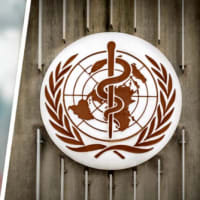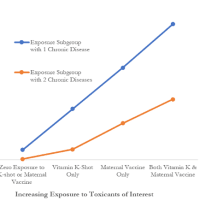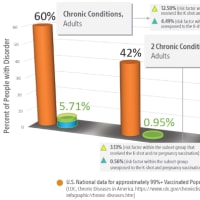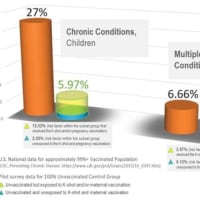
1.CHD 「ワクチン数が多いと乳児死亡率が高い」に対して、最新研究で不適切な攻撃
要約
1.ワクチン接種率が高く(一貫して90%以上)、社会経済的要因が均一な30の最も高度に発展した国を分析
In 2011, Miller and Goldman published a peer-reviewed study in Human and Experimental Toxicology, which first identified a positive statistical correlation between IMRs and number of vaccine doses.
2011 年、Miller と Goldman は、ヒューマン アンド エクスペリメンタル トキシコロジー誌に査読済みの研究を発表しました。この研究では、乳児死亡率IMR とワクチン接種回数との間の正の統計的相関関係が初めて特定されました。
“Using linear regression, the immunization schedules of these 34 nations were examined and a correlation coefficient of r = 0.70 (p < 0.0001) was found between IMRs and the number of vaccine doses routinely given to infants.”
「線形回帰を使用して、これら 34 か国の予防接種スケジュールを調べたところ、IMR と定期的に乳児に投与されたワクチン接種回数との間に r = 0.70 (p < 0.0001) の相関係数が見つかりました。」
2.対照的に、私たちの批評家は、可変的なワクチン接種率 (40% 未満から 90% 以上までの範囲) と不均一な社会経済的要因を持つ 185 の国を分析
The 10 researchers — Elizabeth G. Bailey, Ph.D., a biology assistant professor at Brigham Young University, and several students associated with her Bioinformatics Capstone course who wrote the rebuttal to Goldman and Miller’s 2011 analysis — combined “185 developed and Third World nations that have varying rates of vaccination and socioeconomic disparities” in their analysis.
10 人の研究者 — ブリガム ヤング大学の生物学助教授であるエリザベス G. ベイリー博士と、ゴールドマンとミラーの 2011 年の分析に対する反論を書いた彼女のバイオインフォマティクス キャップストーン コースに関連する数人の学生 —
彼らの分析では、「ワクチン接種率と社会経済的格差が異なる185の先進国と第三世界の国」を組み合わせました。
訳注:
185の先進国と第三世界の国を対象にすると、栄養及び衛生環境が良好な先進国と、それらが不良な発展途上国をごちゃまぜにして計算することになる。乳児死亡率を支配する因子として、栄養及び衛生環境が極めて強力な因子であることは、世界の常識である。これらが大きく異なる国々を混合すると、ワクチンによる作用は消滅あるいは減少し、強力な栄養及び衛生環境の作用が計算結果を支配してしまい、ワクチンの作用が評価できなくなる。全世界185の国を評価せよと言うのなら、先進国と第三世界の国を分離して評価するのが医学的に正しい評価である。
According to Miller, “Despite the presence of inherent confounding variables in their paper, a small, statistically significant positive correlation (r = 0.16, p < .03) is reported that corroborates the positive trend in our study (r = 0.70, p < .0001).”
Miller によると、「彼らの論文には固有の交絡変数が存在するにもかかわらず、統計的に有意な小さな正の相関 (r = 0.16、p < .03) が報告されています。これは、私たちの研究における肯定的な傾向を裏付けています (r = 0.70、p < .0001)。
In other words, there is still a positive correlation between the IMR and the number of vaccine doses, albeit weaker, among the 185 countries Miller’s critics studied.
言い換えれば、ミラーの批評家が調査した 185 か国の中で、IMR とワクチン接種回数の間には、弱いながらも正の相関関係がまだあります。
However, this positive correlation is “attenuated in the background noise of nations with heterogeneous socioeconomic variables that contribute to high rates of infant mortality, such as malnutrition, poverty, and substandard health care” — meaning that there are confounding factors in poorer nations that significantly contribute to their higher IMRs.
しかし、この正の相関関係は、「乳児死亡率の高さに寄与する異質な社会経済的変数を持つ国のバックグラウンド ノイズの中で減衰し、
栄養失調、貧困、標準以下のヘルスケアなど」 - 貧しい国には、より高い IMR に大きく寄与する交絡因子があることを意味します。
Miller explained the difference in methodologies:
Miller 氏は、方法論の違いについて次のように説明しています。
“We both used linear regression to analyze a potential correlation between the number of vaccine doses and IMRs.
「私たちは両方とも線形回帰を使用して、ワクチン接種回数と IMR の間の潜在的な相関関係を分析しました。
However, we analyzed the 30 most highly developed nations with high vaccination rates (consistently above 90%) and uniformity of socioeconomic factors.
ただし、ワクチン接種率が高く(一貫して90%以上)、社会経済的要因が均一な30の最も高度に発展した国を分析しました。
“In contrast, our critics analyzed 185 nations with variable vaccination rates (ranging from less than 40% to greater than 90%) and heterogeneous socioeconomic factors.
「対照的に、私たちの批評家は、可変的なワクチン接種率 (40% 未満から 90% 以上までの範囲) と不均一な社会経済的要因を持つ 185 の国を分析しました。
“By mixing highly developed and Third World nations in their analysis, our critics inadvertently introduced numerous confounders.
「高度に発展した国と第三世界の国々を分析に混ぜ合わせることで、私たちの批評家はうっかり多くの交絡因子を持ち込んでしまいました。
For example, malnutrition, poverty, and substandard healthcare all contribute to infant mortality, confounding the data and rendering the results unreliable.”
たとえば、栄養失調、貧困、標準以下の医療はすべて乳児死亡率に寄与し、データを混乱させ、結果の信頼性を低下させます。」
訳注
このような医学的に不適切な解析の目的は、ワクチンと乳児死亡率の関係が、強いものではなく、弱いものであると見せかけるためです。
++++++++++++++++++++++++++++++++++++++
https://childrenshealthdefense.org/defender/infant-mortality-vaccine-doses/?itm_term=home
02/07/23 Children’s Health Defense 2023年2月7日 子供の健康防衛
Higher Infant Mortality Rates Linked to Higher Number of Vaccine Doses, New Study Confirms
乳児死亡率の上昇はワクチン接種回数の増加に関連していることが新たな研究で確認された
A new peer-reviewed study found a positive statistical correlation between infant mortality rates and the number of vaccine doses received by babies — confirming findings made by the same researchers a decade ago.
新しい査読済み研究では、乳児死亡率と赤ちゃんが受けたワクチン接種回数との間に正の統計的相関関係があることがわかりました
— 10 年前に同じ研究者が行った調査結果を確認します。
A new peer-reviewed study found a positive statistical correlation between infant mortality rates (IMRs) and the number of vaccine doses received by babies — confirming findings made by the same researchers a decade ago.
新しい査読済み研究では、乳児死亡率(IMR)と赤ちゃんが受けたワクチン接種回数との間に正の統計的相関関係があることがわかりました
— 10 年前に同じ研究者が行った調査結果を確認します。
In “Reaffirming a Positive Correlation Between Number of Vaccine Doses and Infant Mortality Rates: A Response to Critics,” published Feb. 2 in Cureus, authors Gary S. Goldman, Ph.D., an independent computer scientist, and Neil Z. Miller, a medical researcher, examined this potential correlation.
2月2日にCureusに掲載された「ワクチン接種回数と乳児死亡率の間の正の相関を再確認する:批評家への対応」で、
著者の Gary S. Goldman 博士 (独立系コンピューター科学者) と Neil Z. Miller (医学研究者) は、この潜在的な相関関係を調べました。
Their findings indicate a “positive correlation between the number of vaccine doses and IMRs is detectable in the most highly developed nations” — which, on average, administer the most vaccine doses to infants.
彼らの調査結果は、「ワクチンの接種回数と IMR の間の正の相関関係は、平均して乳児に最も多くのワクチンを投与している先進国で検出可能である」ことを示しています。
The authors replicated the results of a 2011 statistical analysis they conducted, and refuted the results of a recent paper that questioned those findings.
著者らは、2011 年に行った統計分析の結果を再現し、それらの調査結果に疑問を呈した最近の論文の結果に反論しました。
Miller spoke to The Defender about the study and its implications for infant and childhood vaccination schedules.
Miller は The Defender に、この研究と、乳児および小児期の予防接種スケジュールへの影響について話しました。
The more doses, the higher the infant mortality rate
投与量が多いほど乳児死亡率が高くなる
In 2011, Miller and Goldman published a peer-reviewed study in Human and Experimental Toxicology, which first identified a positive statistical correlation between IMRs and number of vaccine doses.
2011 年、Miller と Goldman は、ヒューマン アンド エクスペリメンタル トキシコロジー誌に査読済みの研究を発表しました。この研究では、IMR とワクチン接種回数との間の正の統計的相関関係が初めて特定されました。
The researchers wrote:
研究者は次のように書いています。
“The infant mortality rate (IMR) is one of the most important indicators of the socio-economic well-being and public health conditions of a country.
「乳児死亡率 (IMR) は、国の社会経済的幸福と公衆衛生状態の最も重要な指標の 1 つです。
The U.S. childhood immunization schedule specifies 26 vaccine doses for infants aged less than 1 year — the most in the world — yet 33 nations have lower IMRs.
米国の小児期の予防接種スケジュールでは、1 歳未満の乳児に 26 回のワクチン接種を指定しています。
世界で最も多いですが、33 か国の IMR が低くなっています。
“Using linear regression, the immunization schedules of these 34 nations were examined and a correlation coefficient of r = 0.70 (p < 0.0001) was found between IMRs and the number of vaccine doses routinely given to infants.”
「線形回帰を使用して、これら 34 か国の予防接種スケジュールを調べたところ、IMR と定期的に乳児に投与されたワクチン接種回数との間に r = 0.70 (p < 0.0001) の相関係数が見つかりました。」
In the above figures, “r” refers to the correlation coefficient, a number that ranges from -1 to 1.
上の数字で、「r」は相関係数を指し、-1 から 1 の範囲の数値です。
Any figure above zero is understood as a positive correlation, with figures between 0.6 and 0.79 considered a “strong” positive correlation, and 0.8 and above a “very strong” positive correlation.
ゼロを超える数値は正の相関と見なされ、0.6 ~ 0.79 の数値は「強い」正の相関と見なされ、0.8 以上は「非常に強い」正の相関と見なされます。
The “p-value” indicates the extent to which the predictor’s value, in a linear regression analysis, is related to changes in the response variable.
「p値」は、線形回帰分析における予測変数の値が応答変数の変化にどの程度関連しているかを示します。
A p-value of 0.05 or below is considered statistically significant, and indicative that the predictor and the response variable are related to each other and move in the same direction.
0.05 以下の p 値は統計的に有意であると見なされ、予測変数と応答変数が互いに関連しており、同じ方向に移動していることを示しています。
In the same 2011 study, which used 2009 data, the researchers found the highest positive correlation in countries that administered the most vaccine doses to infants (between 21 and 26 months old).
2009 年のデータを使用した同じ 2011 年の研究で、研究者は乳児 (生後 21 ~ 26 か月) に最も多くのワクチンを投与した国で最も高い正の相関関係を発見しました。
“Linear regression analysis of unweighted mean IMRs showed a high statistically significant correlation between increasing number of vaccine doses and increasing infant mortality rates, with r = 0.992 (p = 0.0009),” the researchers wrote.
「重み付けされていない平均IMRの線形回帰分析は、ワクチン接種回数の増加と乳児死亡率の増加との間に統計的に有意な高い相関関係を示し、r = 0.992(p = 0.0009)でした」と研究者は書いています.
Miller told The Defender:
Miller 氏は The Defender に次のように語っています。
“In 2011, we published a study that found a counterintuitive, positive correlation, r = 0.70 (p < .0001), demonstrating that among the most highly developed nations (n = 30), those that require more vaccines for their infants tend to have higher infant mortality rates (IMRs).”
「2011 年に、私たちは直観に反する正の相関、r = 0.70 (p < .0001) を発見した研究を発表しました。
乳児により多くのワクチンを必要とする国は、乳児死亡率 (IMR) が高くなる傾向があります。」
However, “critics of the paper recently claimed that this finding is due to ‘inappropriate data exclusion,’ i.e., the failure to analyze the ‘full dataset’ of all 185 nations.”
しかし、「この論文の批評家は最近、この調査結果は『不適切なデータ除外』、つまり 185 か国のすべての『完全なデータセット』を分析できなかったことが原因であると主張しました。」
According to Miller:
ミラーによると:
“A team of researchers recently read our study and found it ‘troublesome’ that it’s in the top 5% of all research outputs. They wrote a rebuttal to our paper to ‘correct past misinformation’ and to reduce the impact of vaccine hesitancy.
「研究者チームが最近私たちの研究を読んだところ、全研究成果の上位 5% に含まれていることは『厄介』であることがわかりました。 彼らは、「過去の誤った情報を修正」し、ワクチンへの躊躇の影響を減らすために、私たちの論文に反論を書きました.
“Their paper has not been published but it was posted on a preprint server.”
「彼らの論文は出版されていませんが、プレプリント サーバーに投稿されています。」
Miller said he and Goldman “wrote our current paper to examine the various claims made by these critics, to assess the validity of their scientific methods and to perform new investigations to assess the reliability of our original findings.”
Miller 氏と Goldman 氏は、「これらの批評家によるさまざまな主張を調査し、彼らの科学的方法の妥当性を評価し、新しい調査を行って、最初の発見の信頼性を評価するために、現在の論文を書いた」と述べました。
The original paper studied the U.S. and 29 other countries with better IMRs “to explore a potential association between the number of vaccine doses … and their IMRs,” finding a strong positive correlation.
元の論文では、「ワクチン接種回数と IMR との潜在的な関連性を調査するために」、米国と IMR が良好な他の 29 か国を調査し、強い正の相関関係を発見しました。
The 10 researchers — Elizabeth G. Bailey, Ph.D., a biology assistant professor at Brigham Young University, and several students associated with her Bioinformatics Capstone course who wrote the rebuttal to Goldman and Miller’s 2011 analysis — combined “185 developed and Third World nations that have varying rates of vaccination and socioeconomic disparities” in their analysis.
10 人の研究者 — ブリガム ヤング大学の生物学助教授であるエリザベス G. ベイリー博士と、ゴールドマンとミラーの 2011 年の分析に対する反論を書いた彼女のバイオインフォマティクス キャップストーン コースに関連する数人の学生 —
彼らの分析では、「ワクチン接種率と社会経済的格差が異なる185の先進国と第三世界の国」を組み合わせました。
(訳注:
185の先進国と第三世界の国を対象にすると、栄養及び衛生環境が良好な先進国と、それらが不良な発展途上国をごちゃまぜにして計算することになる。乳児死亡率を支配する因子として、栄養及び衛生環境が極めて強力な因子であることは、世界の常識である。これらが大きく異なる国々を混合すると、ワクチンによる作用は消滅あるいは減少し、強力な栄養及び衛生環境の作用が計算結果を支配してしまい、ワクチンの作用が評価できなくなる。全世界185の国を評価せよと言うのなら、先進国と第三世界の国を分離して評価するのが医学的に正しい評価である。)
“One stated rationale behind Bailey’s reanalysis (and additional new investigations) is to reduce the impact of vaccine hesitancy, which ‘has intensified due to the rapid development and distribution of the COVID-19 vaccine,’” Goldman and Miller said. “They also appear to be targeting our study for a potential retraction.”
「ベイリーの再分析(および追加の新しい調査)の背後にあると述べられている理論的根拠の1つは、「COVID-19ワクチンの急速な開発と配布により激化した」ワクチン躊躇の影響を減らすことです」とゴールドマンとミラーは述べた. 「彼らはまた、潜在的な撤回のために私たちの研究を標的にしているようです.」
Miller explained the methodology Bailey’s team used:
Miller 氏は、Bailey 氏のチームが使用した方法論について次のように説明しています。
“The critics select[ed] 185 nations and use linear regression to report a correlation between the number of vaccine doses and IMRs.
「批評家は 185 か国を選択し、線形回帰を使用してワクチン接種数と IMR の相関関係を報告しました。
“They also perform[ed] multiple linear regression analyses of the Human Development Index (HDI) vs. IMR with additional predictors and investigate IMR vs. percentage vaccination rates for eight different vaccines.”
「彼らはまた、追加の予測因子を使用して人間開発指数 (HDI) と IMR の多重線形回帰分析を実行し、IMR と 8 つの異なるワクチンのワクチン接種率の割合を調査しました。」
According to Miller, “Despite the presence of inherent confounding variables in their paper, a small, statistically significant positive correlation (r = 0.16, p < .03) is reported that corroborates the positive trend in our study (r = 0.70, p < .0001).”
Miller によると、「彼らの論文には固有の交絡変数が存在するにもかかわらず、統計的に有意な小さな正の相関 (r = 0.16、p < .03) が報告されています。
これは、私たちの研究における肯定的な傾向を裏付けています (r = 0.70、p < .0001)。
In other words, there is still a positive correlation between the IMR and the number of vaccine doses, albeit weaker, among the 185 countries Miller’s critics studied.
言い換えれば、ミラーの批評家が調査した 185 か国の中で、IMR とワクチン接種回数の間には、弱いながらも正の相関関係がまだあります。
However, this positive correlation is “attenuated in the background noise of nations with heterogeneous socioeconomic variables that contribute to high rates of infant mortality, such as malnutrition, poverty, and substandard health care” — meaning that there are confounding factors in poorer nations that significantly contribute to their higher IMRs.
しかし、この正の相関関係は、「乳児死亡率の高さに寄与する異質な社会経済的変数を持つ国のバックグラウンド ノイズの中で減衰し、
栄養失調、貧困、標準以下のヘルスケアなど」 - 貧しい国には、より高い IMR に大きく寄与する交絡因子があることを意味します。
Miller explained the difference in methodologies:
Miller 氏は、方法論の違いについて次のように説明しています。
“We both used linear regression to analyze a potential correlation between the number of vaccine doses and IMRs.
「私たちは両方とも線形回帰を使用して、ワクチン接種回数と IMR の間の潜在的な相関関係を分析しました。
However, we analyzed the 30 most highly developed nations with high vaccination rates (consistently above 90%) and uniformity of socioeconomic factors.
ただし、ワクチン接種率が高く(一貫して90%以上)、社会経済的要因が均一な30の最も高度に発展した国を分析しました。
“In contrast, our critics analyzed 185 nations with variable vaccination rates (ranging from less than 40% to greater than 90%) and heterogeneous socioeconomic factors.
「対照的に、私たちの批評家は、可変的なワクチン接種率 (40% 未満から 90% 以上までの範囲) と不均一な社会経済的要因を持つ 185 の国を分析しました。
“By mixing highly developed and Third World nations in their analysis, our critics inadvertently introduced numerous confounders.
「高度に発展した国と第三世界の国々を分析に混ぜ合わせることで、私たちの批評家はうっかり多くの交絡因子を持ち込んでしまいました。
For example, malnutrition, poverty, and substandard healthcare all contribute to infant mortality, confounding the data and rendering the results unreliable.”
たとえば、栄養失調、貧困、標準以下の医療はすべて乳児死亡率に寄与し、データを混乱させ、結果の信頼性を低下させます。」





















